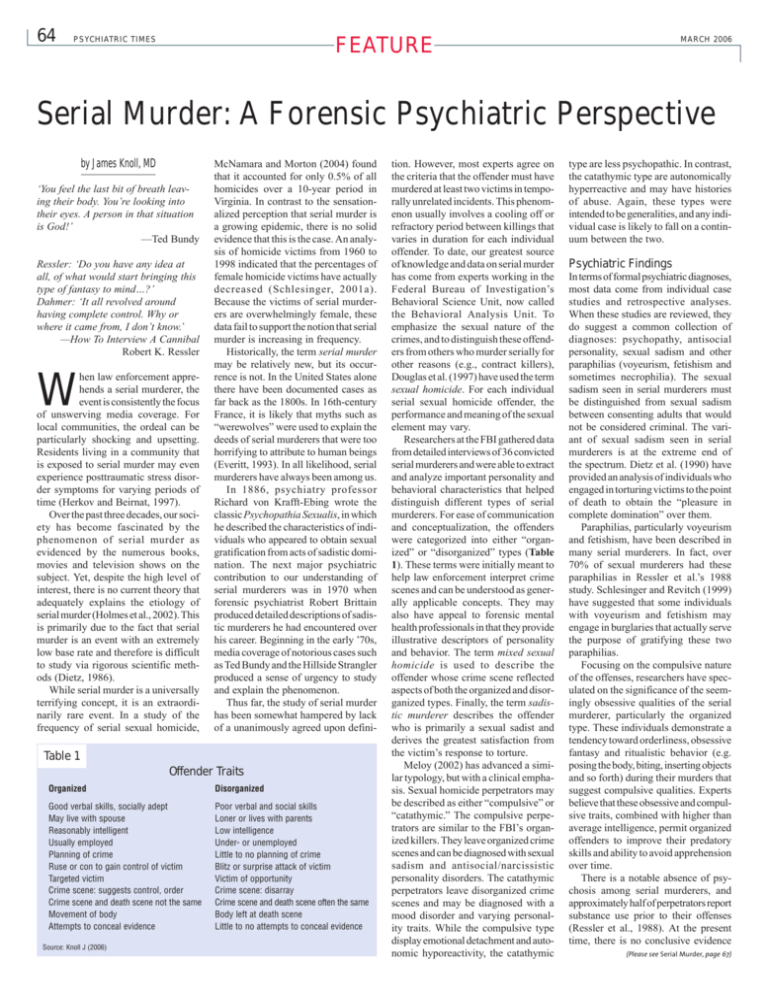
64
PSYCHIATRIC TIMES
MARCH 2006
FEATURE
Serial Murder: A Forensic Psychiatric Perspective
by James Knoll, MD
‘You feel the last bit of breath leaving their body. You’re looking into
their eyes. A person in that situation
is God!’
—Ted Bundy
Ressler: ‘Do you have any idea at
all, of what would start bringing this
type of fantasy to mind…?’
Dahmer: ‘It all revolved around
having complete control. Why or
where it came from, I don’t know.’
—How To Interview A Cannibal
Robert K. Ressler
hen law enforcement apprehends a serial murderer, the
event is consistently the focus
of unswerving media coverage. For
local communities, the ordeal can be
particularly shocking and upsetting.
Residents living in a community that
is exposed to serial murder may even
experience posttraumatic stress disorder symptoms for varying periods of
time (Herkov and Beirnat, 1997).
Over the past three decades, our society has become fascinated by the
phenomenon of serial murder as
evidenced by the numerous books,
movies and television shows on the
subject. Yet, despite the high level of
interest, there is no current theory that
adequately explains the etiology of
serial murder (Holmes et al., 2002). This
is primarily due to the fact that serial
murder is an event with an extremely
low base rate and therefore is difficult
to study via rigorous scientific methods (Dietz, 1986).
While serial murder is a universally
terrifying concept, it is an extraordinarily rare event. In a study of the
frequency of serial sexual homicide,
W
McNamara and Morton (2004) found
that it accounted for only 0.5% of all
homicides over a 10-year period in
Virginia. In contrast to the sensationalized perception that serial murder is
a growing epidemic, there is no solid
evidence that this is the case. An analysis of homicide victims from 1960 to
1998 indicated that the percentages of
female homicide victims have actually
decreased (Schlesinger, 2001a).
Because the victims of serial murderers are overwhelmingly female, these
data fail to support the notion that serial
murder is increasing in frequency.
Historically, the term serial murder
may be relatively new, but its occurrence is not. In the United States alone
there have been documented cases as
far back as the 1800s. In 16th-century
France, it is likely that myths such as
“werewolves” were used to explain the
deeds of serial murderers that were too
horrifying to attribute to human beings
(Everitt, 1993). In all likelihood, serial
murderers have always been among us.
In 1886, psychiatry professor
Richard von Krafft-Ebing wrote the
classic Psychopathia Sexualis, in which
he described the characteristics of individuals who appeared to obtain sexual
gratification from acts of sadistic domination. The next major psychiatric
contribution to our understanding of
serial murderers was in 1970 when
forensic psychiatrist Robert Brittain
produced detailed descriptions of sadistic murderers he had encountered over
his career. Beginning in the early ’70s,
media coverage of notorious cases such
as Ted Bundy and the Hillside Strangler
produced a sense of urgency to study
and explain the phenomenon.
Thus far, the study of serial murder
has been somewhat hampered by lack
of a unanimously agreed upon defini-
Table 1
Offender Traits
Organized
Disorganized
Good verbal skills, socially adept
May live with spouse
Reasonably intelligent
Usually employed
Planning of crime
Ruse or con to gain control of victim
Targeted victim
Crime scene: suggests control, order
Crime scene and death scene not the same
Movement of body
Attempts to conceal evidence
Poor verbal and social skills
Loner or lives with parents
Low intelligence
Under- or unemployed
Little to no planning of crime
Blitz or surprise attack of victim
Victim of opportunity
Crime scene: disarray
Crime scene and death scene often the same
Body left at death scene
Little to no attempts to conceal evidence
Source: Knoll J (2006)
tion. However, most experts agree on
the criteria that the offender must have
murdered at least two victims in temporally unrelated incidents. This phenomenon usually involves a cooling off or
refractory period between killings that
varies in duration for each individual
offender. To date, our greatest source
of knowledge and data on serial murder
has come from experts working in the
Federal Bureau of Investigation’s
Behavioral Science Unit, now called
the Behavioral Analysis Unit. To
emphasize the sexual nature of the
crimes, and to distinguish these offenders from others who murder serially for
other reasons (e.g., contract killers),
Douglas et al. (1997) have used the term
sexual homicide. For each individual
serial sexual homicide offender, the
performance and meaning of the sexual
element may vary.
Researchers at the FBI gathered data
from detailed interviews of 36 convicted
serial murderers and were able to extract
and analyze important personality and
behavioral characteristics that helped
distinguish different types of serial
murderers. For ease of communication
and conceptualization, the offenders
were categorized into either “organized” or “disorganized” types (Table
1). These terms were initially meant to
help law enforcement interpret crime
scenes and can be understood as generally applicable concepts. They may
also have appeal to forensic mental
health professionals in that they provide
illustrative descriptors of personality
and behavior. The term mixed sexual
homicide is used to describe the
offender whose crime scene reflected
aspects of both the organized and disorganized types. Finally, the term sadistic murderer describes the offender
who is primarily a sexual sadist and
derives the greatest satisfaction from
the victim’s response to torture.
Meloy (2002) has advanced a similar typology, but with a clinical emphasis. Sexual homicide perpetrators may
be described as either “compulsive” or
“catathymic.” The compulsive perpetrators are similar to the FBI’s organized killers. They leave organized crime
scenes and can be diagnosed with sexual
sadism and antisocial/narcissistic
personality disorders. The catathymic
perpetrators leave disorganized crime
scenes and may be diagnosed with a
mood disorder and varying personality traits. While the compulsive type
display emotional detachment and autonomic hyporeactivity, the catathymic
type are less psychopathic. In contrast,
the catathymic type are autonomically
hyperreactive and may have histories
of abuse. Again, these types were
intended to be generalities, and any individual case is likely to fall on a continuum between the two.
Psychiatric Findings
In terms of formal psychiatric diagnoses,
most data come from individual case
studies and retrospective analyses.
When these studies are reviewed, they
do suggest a common collection of
diagnoses: psychopathy, antisocial
personality, sexual sadism and other
paraphilias (voyeurism, fetishism and
sometimes necrophilia). The sexual
sadism seen in serial murderers must
be distinguished from sexual sadism
between consenting adults that would
not be considered criminal. The variant of sexual sadism seen in serial
murderers is at the extreme end of
the spectrum. Dietz et al. (1990) have
provided an analysis of individuals who
engaged in torturing victims to the point
of death to obtain the “pleasure in
complete domination” over them.
Paraphilias, particularly voyeurism
and fetishism, have been described in
many serial murderers. In fact, over
70% of sexual murderers had these
paraphilias in Ressler et al.’s 1988
study. Schlesinger and Revitch (1999)
have suggested that some individuals
with voyeurism and fetishism may
engage in burglaries that actually serve
the purpose of gratifying these two
paraphilias.
Focusing on the compulsive nature
of the offenses, researchers have speculated on the significance of the seemingly obsessive qualities of the serial
murderer, particularly the organized
type. These individuals demonstrate a
tendency toward orderliness, obsessive
fantasy and ritualistic behavior (e.g.
posing the body, biting, inserting objects
and so forth) during their murders that
suggest compulsive qualities. Experts
believe that these obsessive and compulsive traits, combined with higher than
average intelligence, permit organized
offenders to improve their predatory
skills and ability to avoid apprehension
over time.
There is a notable absence of psychosis among serial murderers, and
approximately half of perpetrators report
substance use prior to their offenses
(Ressler et al., 1988). At the present
time, there is no conclusive evidence
(Please see Serial Murder, page 67)
MARCH 2006
Serial Murder
Continued from page 64
that specific organic factors play a causal
role in the creation of a serial murderer.
However, studies have found right
temporal lobe abnormalities (Hucker et
al., 1988) and other neurological abnormalities (Gratzer and Bradford, 1995)
in sexual sadists.
Silva and colleagues (2004, 2002)
have used neuropsychiatric concepts to
approach the study of serial murderers,
most notably Jeffrey Dahmer. They
describe an association between autism
spectrum disorders and a subgroup of
serial murders, and propose that Dahmer
may have suffered from Asperger’s
syndrome. Along these lines, it is interesting to note that after exhaustive interviews with Dahmer, legendary FBI
profiler Robert Ressler was impressed
by the peculiar nature of Dahmer’s
presentation. In fact, Ressler held the
opinion that Dahmer should have been
sent to a psychiatric hospital instead of
prison (Ressler, 2004a).
One of the most reliable psychological findings in the mental lives of serial
murderers is the presence of violent
fantasy. Convicted serial murderers have
consistently described a high frequency
of violent fantasies that are both persistent and arousing (Brittain, 1970;
Johnson and Becker, 1997; Warren et
al., 1996). Behavioral theorists have
speculated that an early developmental
pairing of sexual arousal with aggression is responsible for the deviant fantasy
life seen in serial murderers.
Developmental Theories
Over the past several decades, there
have been a number of different
psychosocial theories put forth on the
etiology of serial murder. Investigators
with significant experience interviewing serial murderers have speculated
that the behavior may result from a
deadly convergence of: 1) early childhood attachment disruptions; 2)
psychopathy; and 3) early traumatogenic abuse (Myers et al., 2005).
However, there is conflicting evidence on the presence of child abuse in
the development of serial murderers.
When the FBI studied 36 serial murderers, many of them had a history of either
abuse or neglect: 43% reported a history
of childhood sexual abuse, and 74%
reported a history of psychological
abuse that typically involved humiliation (Ressler et al., 1988). In contrast,
other studies have found that the majority of sexually sadistic murderers had
no evidence of childhood abuse (Dietz
et al., 1990; Gratzer and Bradford,
1995). One possibility accounting for
these differences may be due to heterogeneity in the populations studied.
When sexual murderers with a
FEATURE
history of sexual abuse were compared
to murderers without such a history,
Ressler et al. (2004) found significant
differences. Sexual murderers with a
history of early sexual abuse were
significantly more likely to begin fantasizing about rape earlier, in addition to
developing more severe sexual
deviancy. In addition to abuse, the
family histories of many sexual murderers reveal unstable environments that
may predispose them to disordered
early life attachments. In one study, 70%
of the sexual murderers’ families had
histories of alcohol abuse, and about
50% had family members with criminal histories (Ressler, 2004b). It is
hypothesized that parental neglect from
either absence or preoccupation with
their own problems might have further
exacerbated these men’s ability to form
healthy attachments.
Animal cruelty appears to be a
common finding in the childhood and
PSYCHIATRIC TIMES
67
adolescent developmental stages of
many serial murderers. The link
between animal cruelty during childhood and subsequent physical violence
during adulthood has been demonstrated in a number of studies (Kellert
and Felthouse, 1985; Tingle et al.,
1986), leading animal cruelty to be
added to the DSM III-TR as a symptom under the diagnosis of conduct
disorder in 1987. In keeping with the
(Please see Serial Murder, page 68)
68
PSYCHIATRIC TIMES
Serial Murder
Continued from page 67
developmental theme of conduct disorder symptoms, researchers have also
commented on a possible link between
childhood fire setting and adult serial
murder (Singer and Hensley, 2004).
Obviously, children who are diagnosed with conduct disorder or engage
in animal cruelty do not all go on to
become serial murderers. Nevertheless,
it is thought that in the cases of those
who do, an early “practicing” of violent
and/or sadistic behavior on a living creature plays a role in desensitizing the
individual to violence against humans.
This notion has been termed “the graduation hypothesis” (Wright and
Hensley, 2003). Indeed, some individuals progress past mere desensitization
and actually derive pleasure and satisfaction from acts of animal cruelty.
Psychodynamically oriented investigators have theorized that a sexually
provocative mother may contribute to
the formation of a serial murderer (Fox
and Levin, 1994; Meloy, 2002). It is
important to note that this premise is
far from another “blaming of the
mother” theory. Rather, investigators
point to documented instances of strikingly inappropriate sexual behavior on
the part of the mother that in some cases
would easily qualify as sexual abuse.
Evaluations of some convicted serial
murderers suggest that a displacement
of aggression from their mothers onto
to their female victims was present
during their offenses.
In summarizing both developmental theories and individual case studies
of serial murderers, some relatively
consistent traits are observed: a strong
need for control/domination, an active
deviant fantasy life, deviant sexual
interests and psychopathic traits. Upon
synthesizing these traits into a gestalt,
the following picture emerges: an individual who spends excessive time in a
reverie of deviant fantasy and has a
tendency toward isolation, a need for
totally submissive partners and a preference for autoerotic pleasure (Grubin,
Table 2
FEATURE
1994). As can be imagined, such an
individual will have a lack of healthy
relationships and subsequently must
depend on fantasy for gratification.
At some point, mere fantasy becomes
an insufficient source of pleasure for the
potential offender. It is theorized that
a gradually progressive series of “tryouts” occur where he attempts to turn
his fantasies into reality. For example,
an offender may begin by simply following a potential victim. This may next
progress to voyeurism or breaking
into victim’s homes as suggested by
Schlesinger and Revitch (1999).
During a burglary, the offender may
steal fetishistic items for sexual pleasure, such as undergarments. When this
fails to provide sufficient satisfaction,
the offender may progress to rape and
ultimately murder. Such behavior is
positively reinforced over time through
paired association with masturbation,
making the deviant fantasies extremely
refractory to extinction (Prentky et al.,
1989). Each time the serial murderer
takes a victim, there is further stimulation of fantasy and an overall reinforcement of the cycle.
Assessment and Prevention
Forensic assessments of suspected serial
murderers are best done by those with
experience evaluating psychopathic and
serial sexual offenders. Dishonesty and
underreporting of deviant fantasies and
offenses are commonplace, and a meticulous review of collateral data prior to
the evaluation is necessary. Individuals
who have already confessed to murders
may nevertheless be unwilling to discuss
the sexual nature of their offenses for a
variety of reasons, the most common
being the fact that sex offenders are
severely harassed by other inmates in
prison.
In an effort to help guide forensic
risk assessments, Schlesinger (2001b)
has put forth a list of 10 ominous signs
(Table 2). The list consists of traits,
characteristics and behaviors that were
frequently found in the backgrounds
of perpetrators of sexual homicides. It
is suggested that when these signs are
Ominous Signs (When Seen in Combination)
Indicate Risk for a Potential Sex Murderer
1. Childhood abuse
2. Inappropriate maternal (sexual) conduct
3. Pathological lying and manipulation
4. Sadistic fantasy with a compulsion to act
5. Animal cruelty, particularly against cats
6. Need to control and dominate others
7. Repetitive firesetting
8. Voyeurism, fetishism, and (sexual) burglary
9. Unprovoked attacks on females, associated with generalized misogynous emotions
10. Evidence of ritualistic (signature) behavior
Source: Schlesinger LB (2001), The potential sex murderer: ominous signs, risk assessment. Journal of
Threat Assessment 1(1):47-62. Reprinted with permission from The Haworth Press, Inc.
seen in combination, the individual
may be predisposed to committing
sexual homicides.
Most experts believe that the prognosis for individuals who have committed
serial murder is extremely poor (Douglas
and Olshaker, 1995; Revitch and
Schlesinger, 1989). At the present time,
a preventive approach is most widely
endorsed. Children and adolescents who
demonstrate sexually sadistic fantasies
or other ominous signs should be followed
closely by mental health professionals
who can direct efforts toward extinguishing the reinforcing cycle and
conducting periodic risk assessments
(Johnson and Becker, 1997).
Conclusions
Regarding the origins of serial murder,
Park Dietz, MD (1986), arguably forensic psychiatry’s leading expert on the
subject, cautioned us:
The tendency of the press, public
and public officials to regard such
individuals as mad solely on the
basis of their crimes reflects the
widespread needs to attribute
such behavior to alien forces.
As difficult as it is to fathom, serial
murder may “simply be part of the spectrum of human possibility, a brutal dark
side of man, not representing demons
or disease” (Drukteinis, 1992).
It is important to recognize how
limited our present understanding is in
terms of the etiology and development
of serial murder, so that erroneous
conclusions are not drawn. While researchers have identified traits and abnormalities common to serial murderers,
there are many who possess these traits
and do not go on to become serial murderers. What is it then that leads some
to act on their deviant fantasies while
others do not? Until future research can
help further clarify this question, Dietz
suggested that, in his experience, “the
leap from fantasy to action has much to
do with character and the vicissitudes
of life” (Simon, 1996).
Dr. Knoll is the director of forensic psychiatry
at Dartmouth Medical School and director of
forensic services at the New Hampshire
Department of Corrections. In addition, he
performs forensic psychiatry consulting for
law enforcement and security agencies.
Dr. Knoll has indicated he has nothing to disclose regarding the subject matter of this article.
References
Brittain RP (1970), The sadistic murderer. Med Sci
Law 10(4):198-207.
Dietz PE (1986), Mass, serial and sensational homicides. Bull N Y Acad Med 62(5):477-491.
Dietz PE, Hazelwood RR, Warren J (1990), The sexually sadistic criminal and his offenses. Bull Am
Acad Psychiatry Law 18(2):163-178.
Douglas JE, Burgess AW, Burgess AG, Ressler R, eds.
(1997), Crime Classification Manual: A Standard
System for Investigating and Classifying Violent
Crimes. San Francisco: Jossey Bass Publishers.
MARCH 2006
Douglas JE, Olshaker M (1995), Mind Hunter: Inside
the FBI’s Elite Serial Crime Unit. New York: Scribner.
Drukteinis AM (1992), Serial murder—the heart of
darkness. Psychiatr Ann 22(10):532-538.
Everitt D (1993), Human Monsters: An Illustrated
Encyclopedia of the World’s Most Vicious
Murderers. Chicago: Contemporary Books.
Fox JA, Levin J (1994), Overkill: Mass Murder and
Serial Killing Exposed. New York: Plenum Press.
Gratzer T, Bradford JM (1995), Offender and offense
characteristics of sexual sadists: a comparative
study. J Forensic Sci 40(3):450-455.
Grubin D (1994), Sexual sadism. Criminal Behavior
and Mental Health 4:3-9 [editorial].
Herkov MJ, Biernat M (1997), Assessment of PTSD
symptoms in a community exposed to serial
murder. J Clin Psychol 53(8):809-815.
Holmes ST, Tewksbury R, Holmes RM (2002),
Fractured identity syndrome: a new theory of
serial murder. In: Current Perspectives on Sex
Crimes, Holmes RM, Holmes ST, eds. Thousand
Oaks, Calif.: Sage Publications.
Hucker SJ, Langevin R, Wortzman G et al. (1988),
Cerebral damage and dysfunction in sexually
aggressive men. Annals of Sex Research 1:33-47.
Johnson BR, Becker JV (1997), Natural born killers?:
the development of the sexually sadistic serial
killer. J Am Acad Psychiatry Law 25(3):335-348.
Kellert SR, Felthouse AR (1985), Childhood cruelty
toward animals among criminals and noncriminals. Human Relations 38(12):1113-1129.
McNamara JJ, Morton RJ (2004), Frequency of serial
sexual homicide victimization in Virginia for a
ten-year period. [Published erratum J Forensic
Sci 49(5):1148.] J Forensic Sci 49(3):529-533.
Meloy JR (2002), The nature and dynamics of sexual
homicide: an integrative review. Aggression and
Violent Behavior 5(1):1-22.
Myers WC, Gooch E, Meloy JR (2005), The role of
psychopathy and sexuality in a female serial
killer. J Forensic Sci 50(3):652-657.
Prentky RA, Burgess AW, Rokous F et al. (1989),
The presumptive role of fantasy in serial sexual
homicide. Am J Psychiatry 146(7):887-891.
Ressler RK (2004a), How to interview a cannibal.
In: Profilers: Leading Investigators Take You
Inside the Criminal Mind, Campbell JH, DeNevi
D, eds. Amherst, N.Y.: Prometheus Books.
Ressler RK (2004b), The men who murdered. In:
Profilers: Leading Investigators Take You Inside
the Criminal Mind, Campbell JH, DeNevi D, eds.
Amherst, N.Y.: Prometheus Books.
Ressler RK, Burgess AW, Douglas JE (1988), Sexual
Homicide: Patterns and Motives. Lexington,
Mass.: Lexington Books.
Ressler RK, Burgess AW, Hartman CR et al. (2004),
Murderers who rape and mutilate. In: Profilers:
Leading Investigators Take You Inside the
Criminal Mind, Campbell JH, DeNevi D, eds.
Amherst, N.Y.: Prometheus Books.
Revitch E, Schlesinger LB (1989), Sex Murder and Sex
Aggression: Phenomenology, Psychopathology,
Psychodynamics and Prognosis. Springfield, Ill.:
Charles C. Thomas.
Schlesinger LB (2001a), Is serial homicide really increasing? J Am Acad Psychiatry Law 29(3):294-297.
Schlesigner LB (2001b), The potential sex murderer:
ominous signs, risk assessment. Journal of
Threat Assessment 1(1):47-62.
Schlesinger LB, Revitch E (1999), Sexual burglaries
and sexual homicide: clinical, forensic, and investigative considerations. J Am Acad Psychiatry Law
27(2):227-238.
Silva JA, Ferrari MM, Leong GB (2002), The case
of Jeffrey Dahmer: sexual serial homicide from
a neuropsychiatric developmental perspective.
J Forensic Sci 47(6):1347-1359.
Silva JA, Leong GB, Ferrari MM (2004), A neuropsychiatric developmental model of serial homicidal behavior. Behav Sci Law 22(6):787-799.
Simon RI (1996), Bad Men Do What Good Men
Dream: A Forensic Psychiatrist Illuminates the
Darker Side of Human Behavior. Washington,
D.C.: American Psychiatric Press, Inc., p312.
Singer SD, Hensley C (2004), Applying social learning theory to childhood and adolescent firesetting: can it lead to serial murder? Int J Offender
Ther Comp Criminol 48(4):461-476.
Tingle D, Barnard GW, Robbins L et al. (1986),
Childhood and adolescent characteristics of
pedophiles and rapists. Int J Law Psychiatry
9(1):103-116.
Warren JI, Hazelwood RR, Dietz PE (1996), The sexually sadistic serial killer. J Forensic Sci 41(6):
970-974.
Wright J, Hensley C (2003), From animal cruelty to serial
murder: applying the graduation hypothesis. Int J
Offender Ther Comp Criminol 47(1):71-88. ❒










